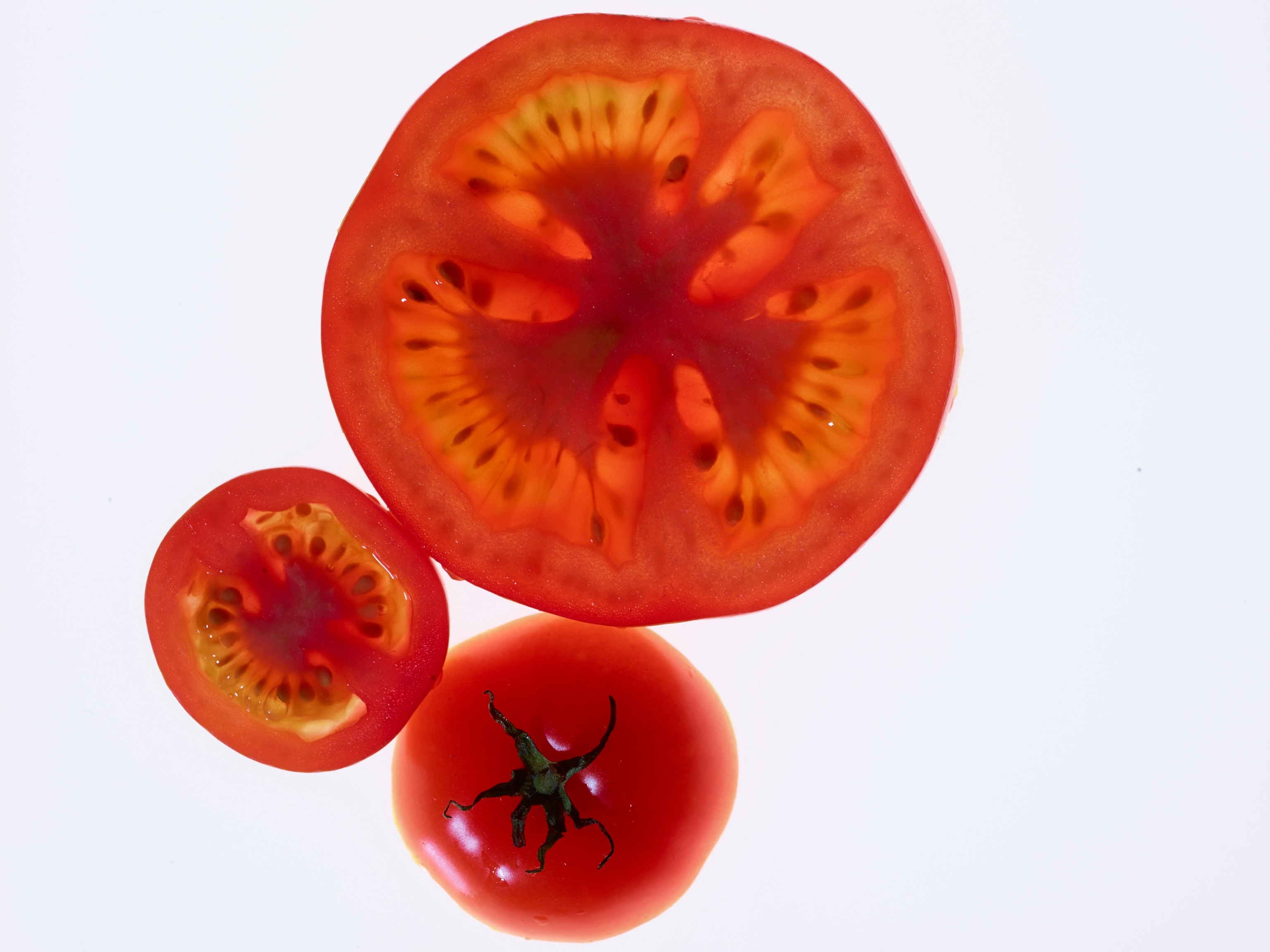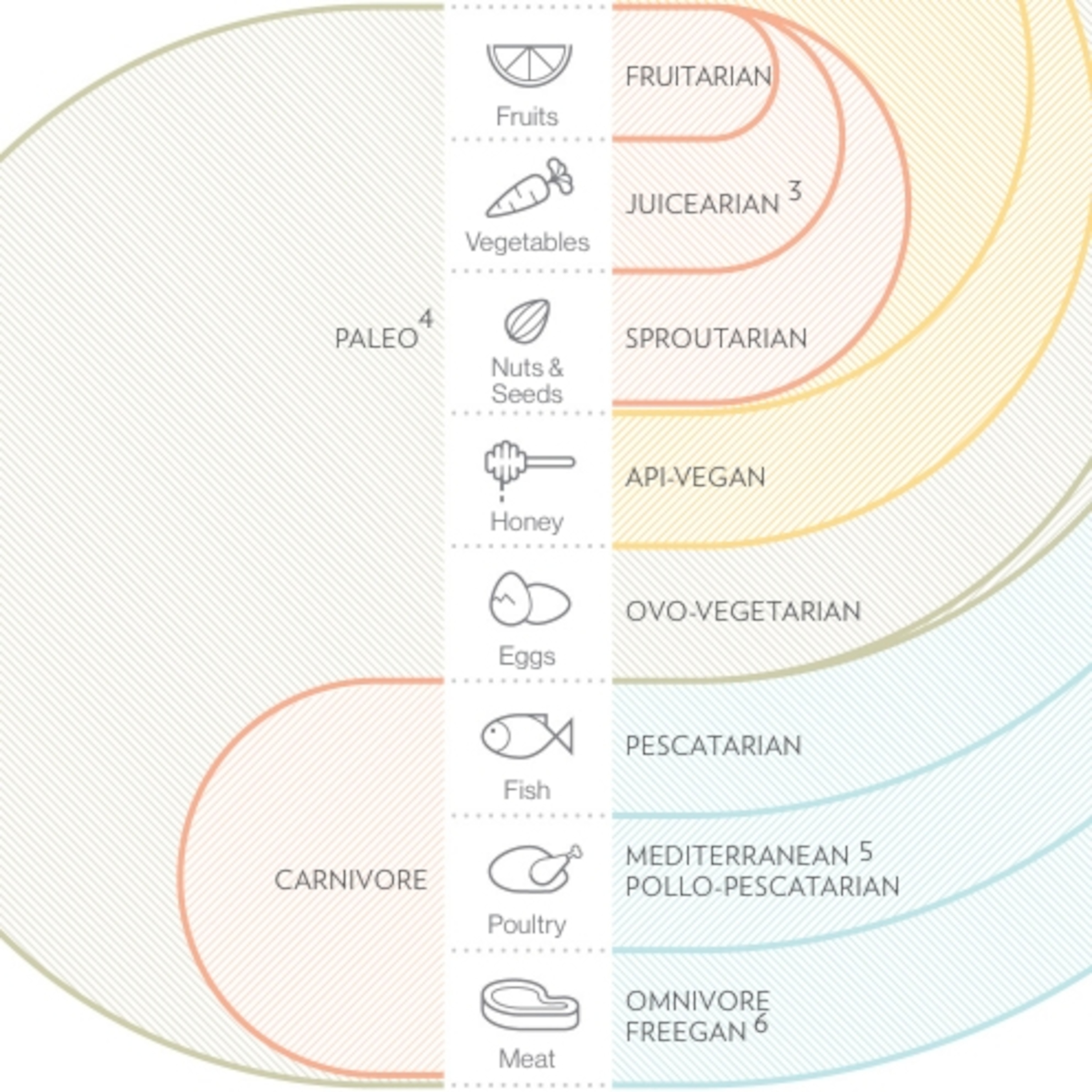
Is a Tomato a Fruit? It Depends on How You Slice It
Everybody knows the difference between a fruit and a vegetable, right? Fruits are tempting and scrumptious. Adam and Eve, unable to resist one, were booted from the blissful Garden of Eden; a fruit kicked off the Trojan War; and a fruit so seduced kidnapped Persephone in the Underworld that she simply couldn’t help taking a bite, thus landing the rest of us forevermore with the chilly season of winter. Vegetables don’t pack this kind of punch. Vegetables, traditionally, are the stuff kids push around on their plates and hide under their mashed potatoes.
So what’s the real difference between fruits and vegetables? Which is which?
To a botanist, a fruit is an entity that develops from the fertilized ovary of a flower. This means that tomatoes, squash, pumpkins, cucumbers, peppers, eggplants, corn kernels, and bean and pea pods are all fruits; so are apples, pears, peaches, apricots, melons and mangos. A vegetable, botanically, is any edible part of a plant that doesn’t happen to be a fruit, as in leaves (spinach, lettuce, cabbage), roots (carrots, beets, turnips), stems (asparagus), tubers (potatoes), bulbs (onions), and flowers (cauliflower and broccoli).
Politically and culinarily, however, it’s a whole different ball game.

The Supreme Court Weighs In
The classical vegetable/fruit story is the tetchy tale of the tomato. In 1886, importer John Nix and colleagues landed a load of West Indian tomatoes at the Port of New York where the resident customs official—one Edward Hedden—demanded payment of a ten percent tax in accordance with the Tariff Act of 1883, which levied an import duty on “foreign vegetables.” Nix, who knew his botany, objected, on the grounds that the tomato –a fruit — should be tax-exempt. The case eventually made its way to the Supreme Court where, in 1893, Justice Horace Gray ruled in favor of vegetable.
“Botanically speaking,” said Justice Gray, “tomatoes are the fruit of the vine, just as are cucumbers, squashes, beans and peas. But in the common language of the people…all these vegetables…are usually served at dinner in, with, or after the soup, fish, or meat, which constitute the principal part of the repast, and not, like fruits, generally as dessert.”
This was neither the first nor the last time that the Supreme Court was forced to struggle with botanical definitions of food. In 1886, Justice Joseph Bradley in Robertson v. Salomon ruled that beans were vegetables. (The lawyer for the protesting importer, arguing that beans were seeds, pointed to garden catalogs; the defense countered with a dinner recipe for baked beans.) “The Supreme Court has just decided that beans are vegetables,” commented a gleeful Iowa newspaper. “This is rough on Boston. That cultured city can no longer push them on to a suffering world as fruit.”
Subsequent court decisions found truffles, onions, and water chestnuts also to be vegetables, but ruled that rhubarb (a leaf petiole or stalk, like celery) was a fruit, presumably from its popularity in strawberry-rhubarb pie. In 2001, the European Union declared carrots, sweet potatoes, and the now thoroughly confused tomatoes all to be fruits, at least for the purpose of making jam.

Oklahoma’s State Vegetable: The Watermelon
State legislatures have muddied the fruit/vegetable waters still more. The custom of creating state symbols dates to the World’s Columbian Exposition of 1893 (a.k.a. the Chicago World’s Fair), where some 27 million visitors viewed 65,000 exhibits, among them the world’s largest conveyor belt, a U.S. map made of pickles, Bach’s clavichord, a herd of ostriches, and a 22,000-pound Canadian cheese. Also featured at the Fair was the National Garland of Flowers, for which each state was asked to select a representative flower.
State flowers were soon followed by a host of other official state symbols, among them birds, trees, animals, insects, reptiles, fossils, minerals, gemstones, songs, and folk dances. Utah and Delaware now have official state stars. Maine, Massachusetts, and North Carolina have official state boats. Texas has designated the cowboy boot its Official State Footwear. In the food category, we have official state fruits, vegetables, nuts, grains, herbs, beverages, muffins, cookies, and pies.
Some state fruit and vegetable decisions have been straightforward. Six states, for example, chose the apple as their symbolic fruit, and three opted for the strawberry. Two—Georgia and South Carolina—chose the peach; Alabama—unable to make up its mind—picked the blackberry as state fruit and the peach as the state tree fruit.
Tennessee and Ohio went with botany and chose the tomato as their state fruit; Arkansas, hedging its bets, decreed the tomato to be both the state’s official fruit and official vegetable. Louisiana, on the other hand, appointed the sweet potato state vegetable, but named the tomato the state’s official “vegetable plant.” (Louisiana’s state fruit is the strawberry; they’ve also got a state doughnut, a state jelly, and a state meat pie.)
Oddest of all, perhaps, is Oklahoma, whose state vegetable, as of 2006, is the watermelon. The Oklahoma watermelon bill was sponsored by senator Don Barrington, Republican, from the watermelon-growing district of Rush Springs, and former winner of a hometown watermelon-seed-spitting contest. Barrington’s argument was that the watermelon was a vegetable by virtue of its genetic relationship to the obviously vegetable (that is, not eaten as dessert) cucumber and gourd; and he got some back-up from the USDA’s National Agricultural Statistics Service, which lists melons under “Vegetables.” The deciding factor, on the other hand, may have been the fact that Oklahoma already had a state fruit: the strawberry.

Fruit’s Place in History
Our word fruit comes to us from the Latin fructus or frui, meaning to enjoy; vegetable, a more stolid, commonsensical kind of word, comes from vegetabilis, which means growing (as in plants). Much of the enjoyable appeal of fruits lies in their irresistible sweetness: most temperate-zone fruits contain about 10 to 15 percent sugar by weight, and tropical fruits, by and large, are even sweeter. A juicy apple or orange, contains about 23 grams of sugar; a banana, 17 grams; a peach, 15; and a ripe fig, 10.
Overall deliciousness explains why fruit tends to lead us into temptation. If thieves sneak into your garden, they’re more likely to pinch the peaches than the peas. In early America, cautionary tales of moral instruction sternly warned that stealing fruit was the sort of gateway sin that led children straight to a life of crime. In Victorian England, filching fruit could get you transported or hanged. Even so, it’s a sin with a long persistent history. Even Saint Augustine, in his pre-sainthood days, admitted to having stolen pears.
No one, however, puts a better spin on stealing fruit than Mark Twain. Twain (along with his most famous hero, Huckleberry Finn) was a shameless stealer of watermelons. In one story, he tells how, as a boy, he lifted a melon out of a farmer’s cart while the farmer was waiting on a customer. He ran away with it, retreated with it to a “secluded bower,” broke it open, and found it green. This led to some soul-searching.
“What ought a boy do who has stolen a green watermelon? What would George Washington do? Now was the time for all the lessons inculcated at Sunday School to act. And they did act. The word that came to me was ‘restitution.’”
So young Twain took the watermelon back to the farmer and conned him into apologizing and handing over a ripe one. Here lies, in my opinion, the solution to the slippery conundrum of fruit vs. vegetable. The watermelon, Oklahoma, is not a vegetable. It’s a fruit.
Nobody goes to that kind of trouble over a vegetable.
References:
- State Symbols USA lists all official state symbols, categorized by both symbol category and state.
- Mark Twain’s Melon is the full text of his speech on “Practical Morality” delivered at the New Savage Club, London.
Related Topics
You May Also Like
Go Further
Animals
- Octopuses have a lot of secrets. Can you guess 8 of them?
- Animals
- Feature
Octopuses have a lot of secrets. Can you guess 8 of them? - This biologist and her rescue dog help protect bears in the AndesThis biologist and her rescue dog help protect bears in the Andes
- An octopus invited this writer into her tank—and her secret worldAn octopus invited this writer into her tank—and her secret world
- Peace-loving bonobos are more aggressive than we thoughtPeace-loving bonobos are more aggressive than we thought
Environment
- Listen to 30 years of climate change transformed into haunting musicListen to 30 years of climate change transformed into haunting music
- This ancient society tried to stop El Niño—with child sacrificeThis ancient society tried to stop El Niño—with child sacrifice
- U.S. plans to clean its drinking water. What does that mean?U.S. plans to clean its drinking water. What does that mean?
- Food systems: supporting the triangle of food security, Video Story
- Paid Content
Food systems: supporting the triangle of food security - Will we ever solve the mystery of the Mima mounds?Will we ever solve the mystery of the Mima mounds?
History & Culture
- Strange clues in a Maya temple reveal a fiery political dramaStrange clues in a Maya temple reveal a fiery political drama
- How technology is revealing secrets in these ancient scrollsHow technology is revealing secrets in these ancient scrolls
- Pilgrimages aren’t just spiritual anymore. They’re a workout.Pilgrimages aren’t just spiritual anymore. They’re a workout.
- This ancient society tried to stop El Niño—with child sacrificeThis ancient society tried to stop El Niño—with child sacrifice
- This ancient cure was just revived in a lab. Does it work?This ancient cure was just revived in a lab. Does it work?
Science
- The unexpected health benefits of Ozempic and MounjaroThe unexpected health benefits of Ozempic and Mounjaro
- Do you have an inner monologue? Here’s what it reveals about you.Do you have an inner monologue? Here’s what it reveals about you.
- Jupiter’s volcanic moon Io has been erupting for billions of yearsJupiter’s volcanic moon Io has been erupting for billions of years
- This 80-foot-long sea monster was the killer whale of its timeThis 80-foot-long sea monster was the killer whale of its time
Travel
- How to plan an epic summer trip to a national parkHow to plan an epic summer trip to a national park
- This town is the Alps' first European Capital of CultureThis town is the Alps' first European Capital of Culture
- This royal city lies in the shadow of Kuala LumpurThis royal city lies in the shadow of Kuala Lumpur
- This author tells the story of crypto-trading Mongolian nomadsThis author tells the story of crypto-trading Mongolian nomads







